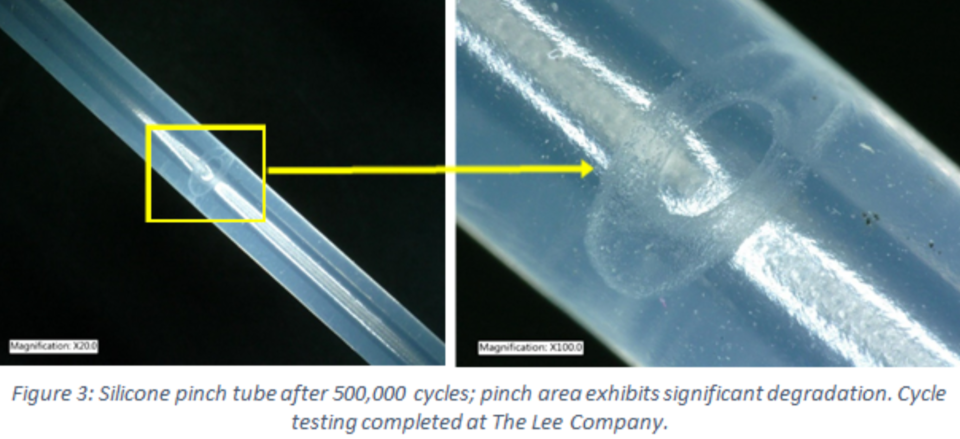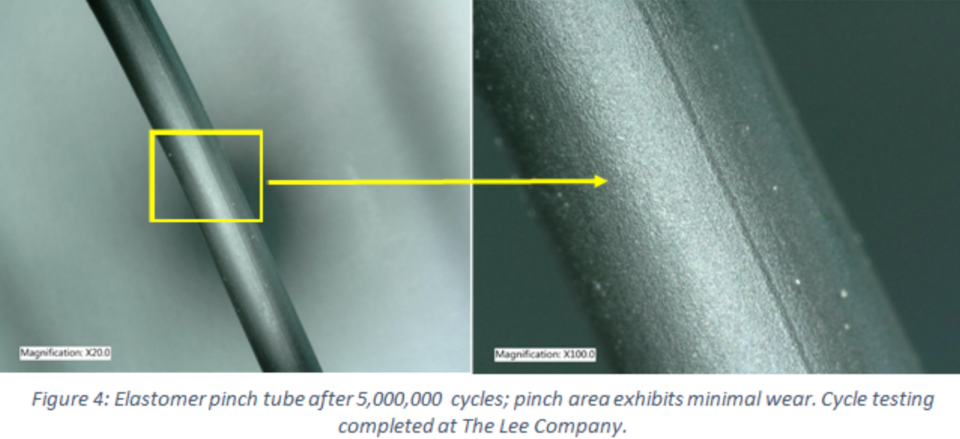There are two primary types of pinch valves used in the medical and scientific industries: external and internal. Each has benefits and drawbacks, depending upon its end-use.
The core functionality of a pinch valve is a flexible flow path element that is compressed by an external plunger or pinch block. Most pinch valves employed in these industries are actuated using a solenoid, although some manual hand-actuated pinch valves exist, and they operate like a clamp.
|
|
Internal Pinch Valve | External Pinch Valve |
| Minimized Internal Volume | X | X |
| Low Carryover Volume | X | |
| Maintenance Free | X | |
| Replaceable Flow Path | X |
Figure 6: General comparison of features between internal and external pinch valves.
External pinch valves are characterized by tubing that can be easily replaced; internal pinch valves are sealed and maintenance-free. The choice of which valve to purchase for a scientific or medical instrument application is dependent upon several factors. Consideration should be given to the internal volume, carryover volume, maintenance, cycle life, and materials. These factors are discussed in greater detail below.
The internal volume of flow path components is a frequent design consideration for the medical and scientific industries. Instrument designers focus upon the reduction of expensive reagents, patient sample sizes, and fluid loss during medical treatments.
The internal volume of a pinch valve, for external and internal styles, is determined by the inner diameter (ID) and length of the tubing. The ID of pinch valve tubing is generally based on the flow capacity required for a given application. Most medical and scientific applications choose a tubing ID of 1.5 mm or less, equating to a flow of less than 50 mL per minute. If the internal volume is a priority, it is important to choose a valve with a total flow restriction that leaves little margin above your pressure drop requirements.
| Tubing Inner Diameter (inches / mm) | Volume (µL) | Approximate Water Flow With 1psi Drop (mL/minute) |
| 0.020 inch / 0.5 mm | 20 | 9 |
| 0.031 (1/32) inch / 0.8 mm | 49 | 30 |
| 0.040 inch / 1.0 mm | 81 | 60 |
| 0.062 (1/16) inch / 1.6 mm | 195 | 200 |
| 0.125 (1/8) inch / 3.2 mm | 792 | 2,100 |
Figure 1: Comparison of volume for a 10cm length of tubing of common inner diameters.
When the tubing ID is selected, consideration must be given to tubing length. The tubing and pinch block in internal pinch valves are enclosed in the port head and typically offer a minimized tube length—and as such, the lowest internal volume for a given tubing inner diameter. This advantage is particularly noticeable with 3-way valves because the joining point (Y-connector) for an external pinch valve is located externally to the valve.
Carryover volume refers to the amount of fluid volume remaining after a valve switches state. For 2-way “on-off” pinch valves, this is usually not a concern; however, for 3-way pinch valves, the volume carried over can mix with other fluids and is wasted when it is flushed out. Therefore, minimizing this volume is very important. Internal pinch valves offer a major benefit when carryover volume is a consideration because the volume between the pinch point and Y-shaped combination point is minimized.
Design considerations for medical or scientific instruments focus heavily on maintenance requirements and costs. When these factors are a prime concern, the internal pinch valve is the better choice. These valves are typically rated to 5 million or more cycles prior to replacement. In comparison, external pinch valves typically require tubing replacement every 200,000 to 500,000 cycles, although the solenoid actuators have similar life ratings to that of the internal pinch valves.
The difference between internal and external pinch valve tubing life can be explained by examining the properties of common tubing materials. Inexpensive silicone and flexible PVC tubing, normally used in external pinch valves, wears out easily and must be replaced frequently. Elastomeric tubing materials such as EPDM or the fluoroelastomer FKM commonly used in internal pinch valves offer life ratings an order of magnitude better—with a trade-off of slightly higher upfront costs.


The stark difference in cycle life (driven by the choice of material) is a key determinant in the selection of a pinch valve for a specific application. External pinch valves are best used in applications where flow path replacement is a requirement, particularly for in-vivo medical applications. For example, dialysis machines frequently replace tubing used to carry blood to eliminate cross-contamination risk. An internal pinch valve—with its maintenance-free design—is a better choice for in-vitro diagnostic applications where a cleaning solution can be used between patient samples.
| Fluoro-Elastomer (FKM, FFKM) | EPDM | Silicone (VMQ) | Fluoro-Silicone | Flexible PVC | |
| Tensile Strength | Excellent | Excellent | Fair | Fair | Good |
| Abrasion Resistance | Good | Good | Poor | Poor | Good |
| Tear Resistance | Fair | Excellent | Poor | Poor | Good |
Figure 5: General Dynamic Properties of Common Pinch Valve Tubing Materials
A critical consideration in the selection of pinch valves is the materials used in the flow path. External pinch valves feature a single wetted material: the pinch tubing. The available tubing options vary considerably; the choice of tubing is based on compatibility with biological fluids and organic solvents. It is, therefore, important to perform tests for each application. Tubing connectors need to be selected and separately qualified. Internal pinch valves—with integrated tubing connectors such as hose barbs or threaded fittings—typically have more than one wetted material. These materials are selected for compatibility with a wide variety of applications because they are much more difficult to adjust. Therefore, compatibility issues are rare.
The selection of internal or external pinch valves for applications such as analytical chemistry, diagnostics, medical equipment, or next-generation sequencing, must be carefully examined. In general, internal pinch valves are the best choice when low internal volume, low carryover volume, and long life are important factors. External pinch valves are a great solution for applications where easy tubing replacement is a desirable attribute. Both valve types offer clean flow paths, relatively low internal volumes (as compared to other types of valves), and excellent compatibility with fluids commonly used in the medical and scientific industries.
Xover® is a breakthrough in quick and easy flow selection with its innovative pinch-tube design and low carryover volume. This component combines the flow path of a pinch valve with the versatile, maintenance-free performance of a chemically inert isolation valve to power critical applications in high-tech medical and scientific instruments. Learn more about Xover solenoid valves.
Our global sales force of technical sales engineers is available to provide fast, accurate customer assistance and help you find the best solution for your fluid control challenge.
Always verify flow calculations by experiment.
*There are many parameters to consider when determining V-Factor. Click here for more information.